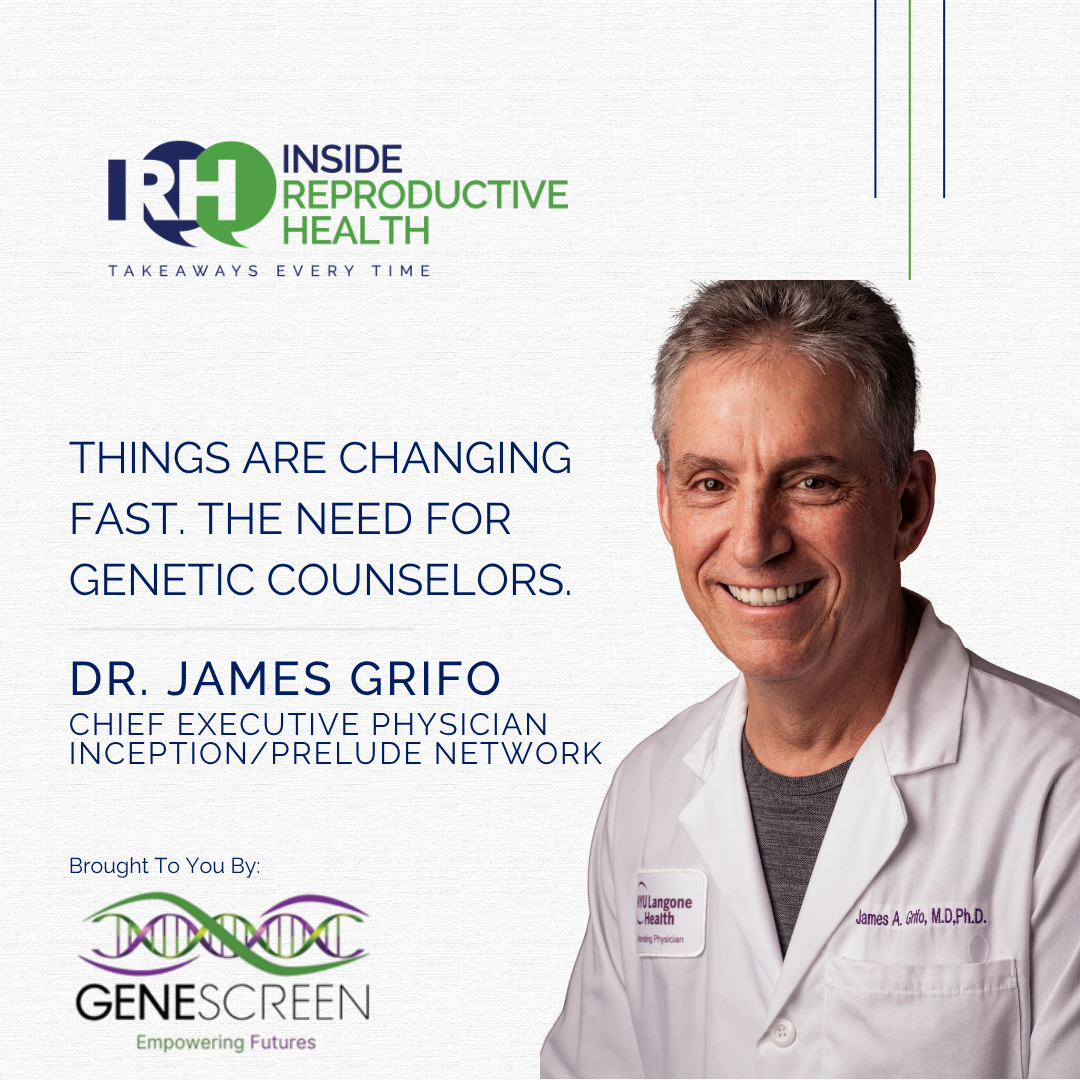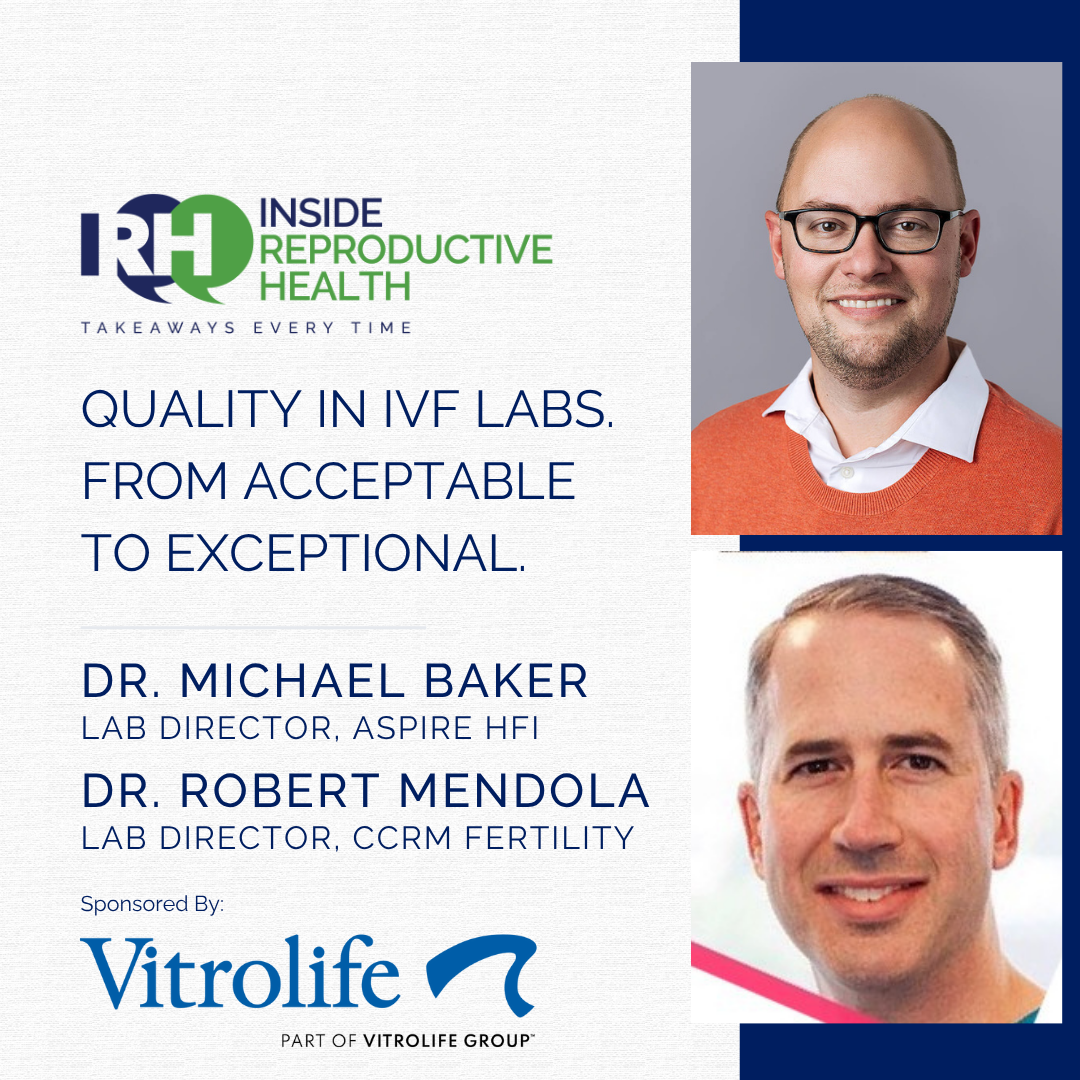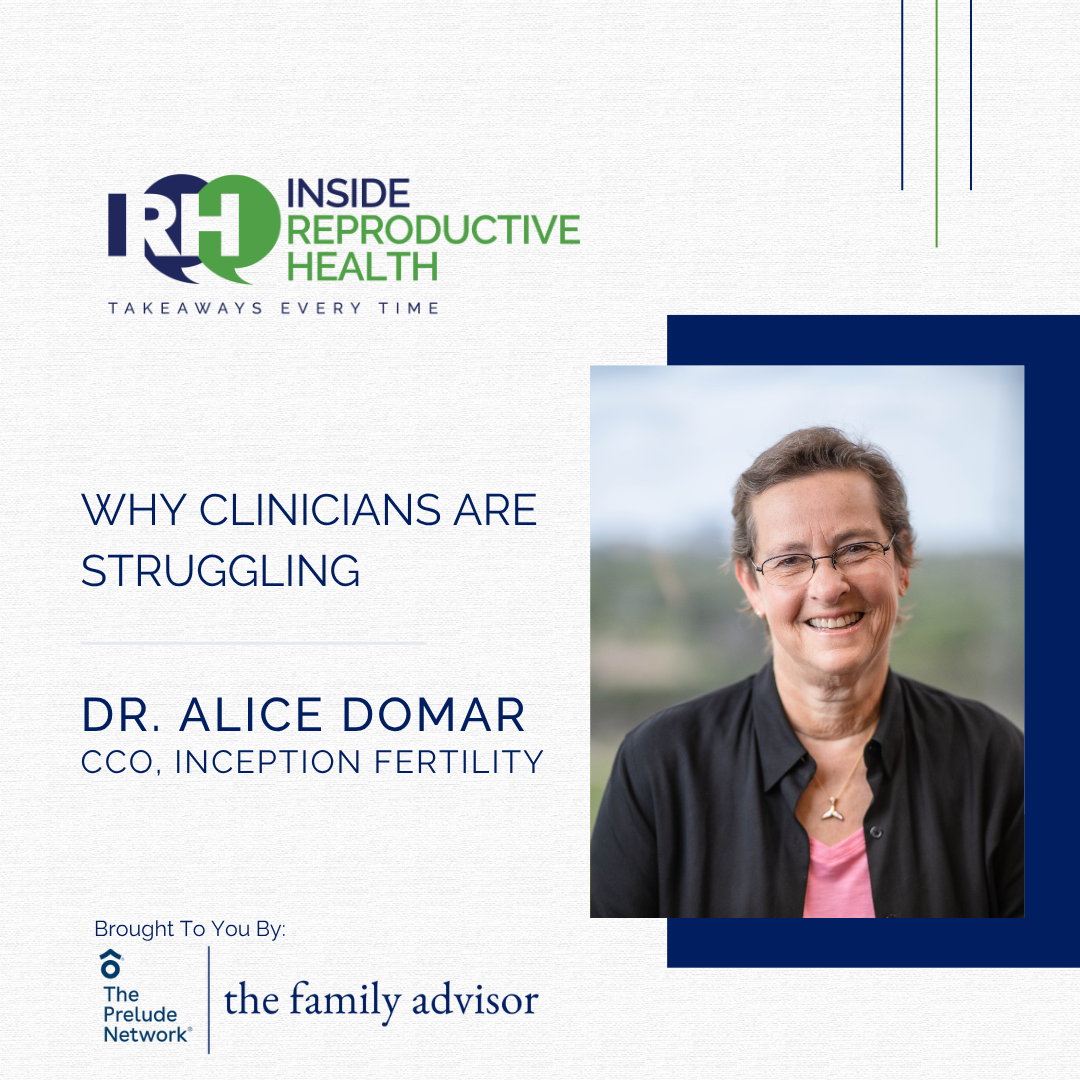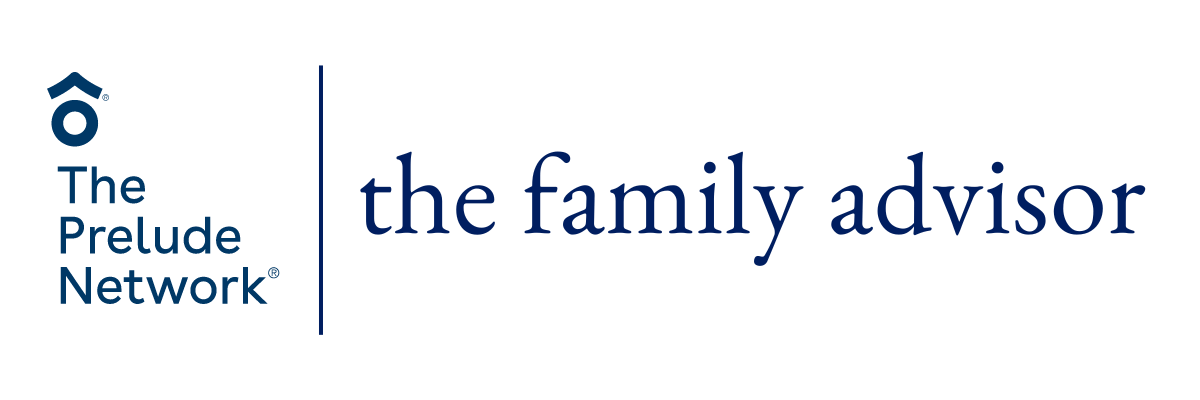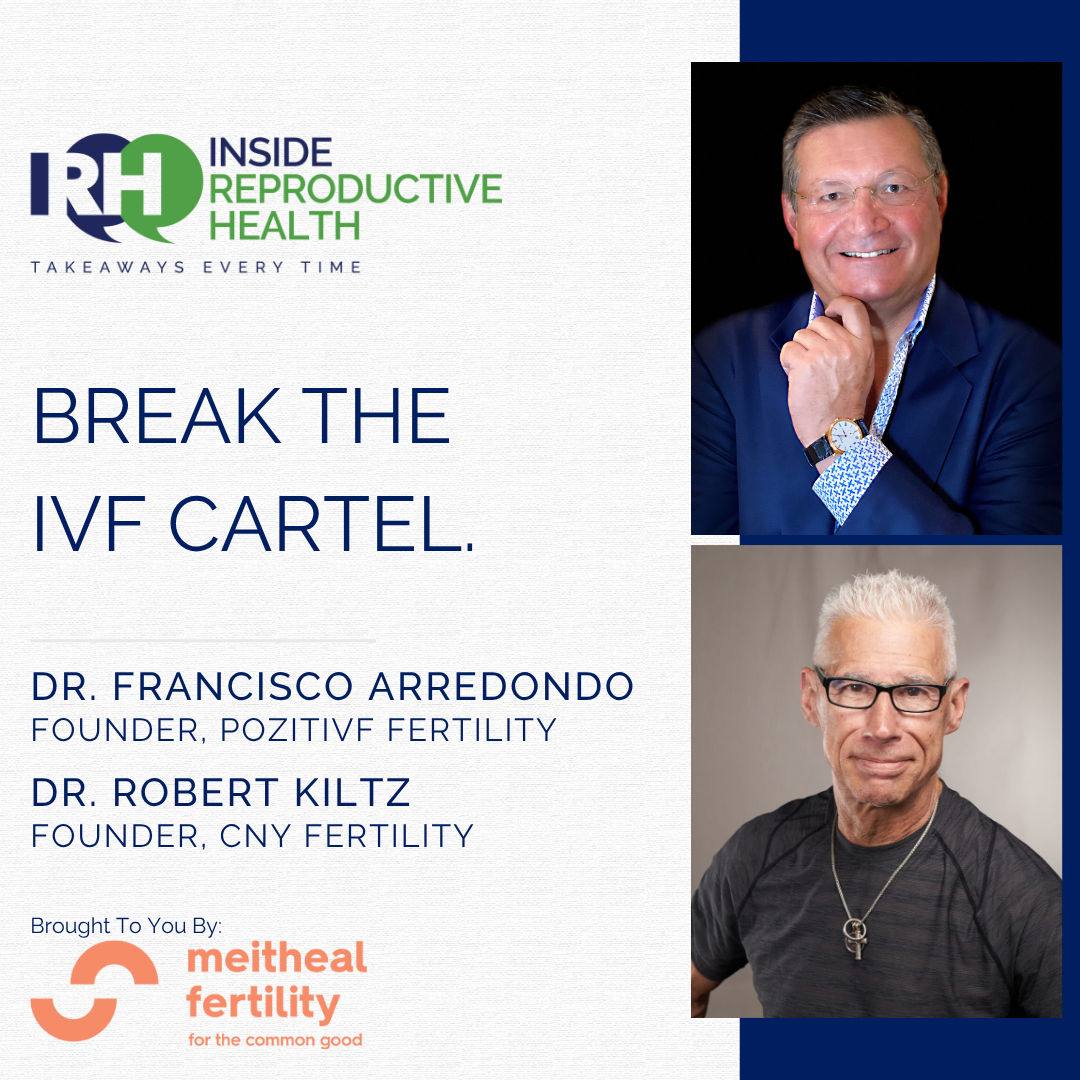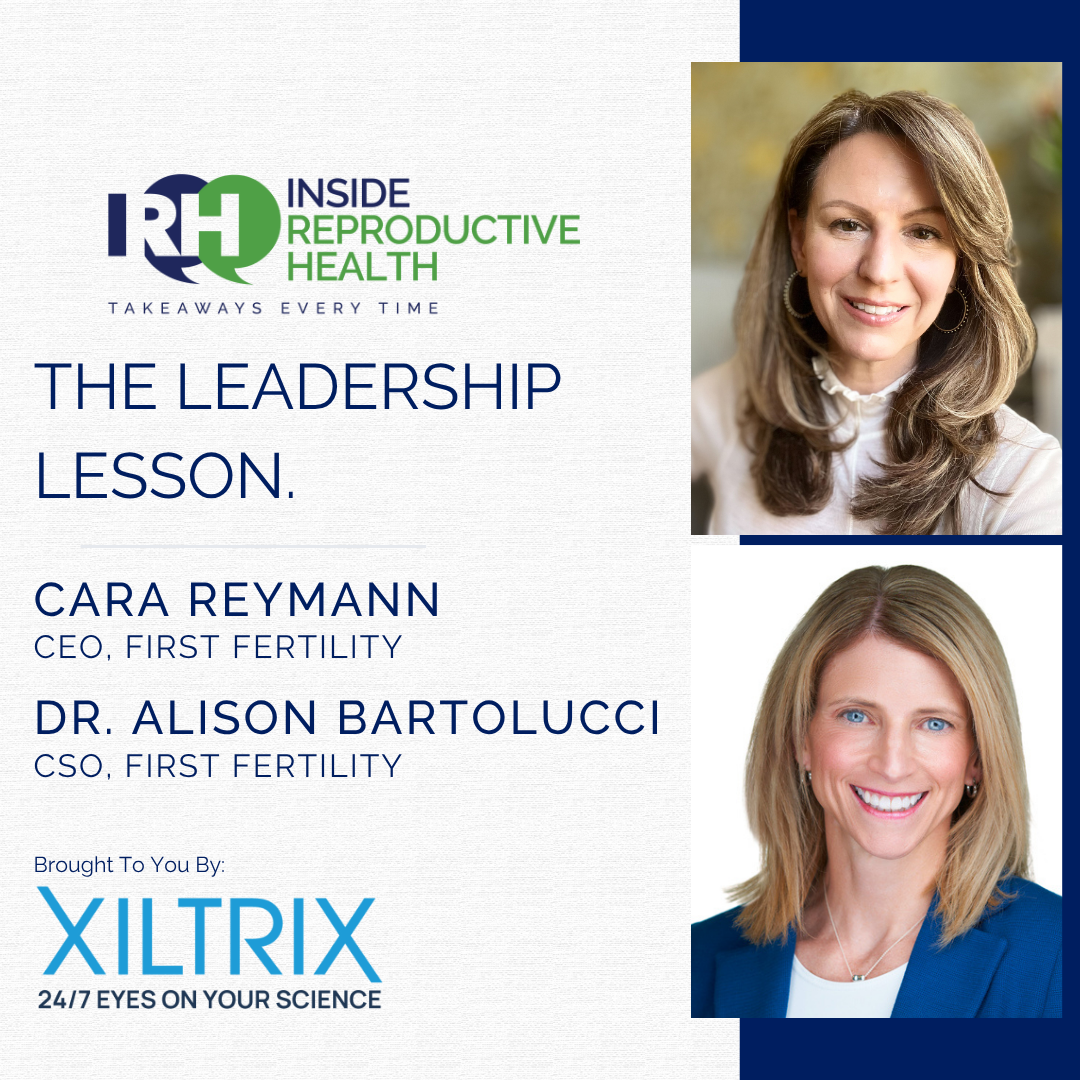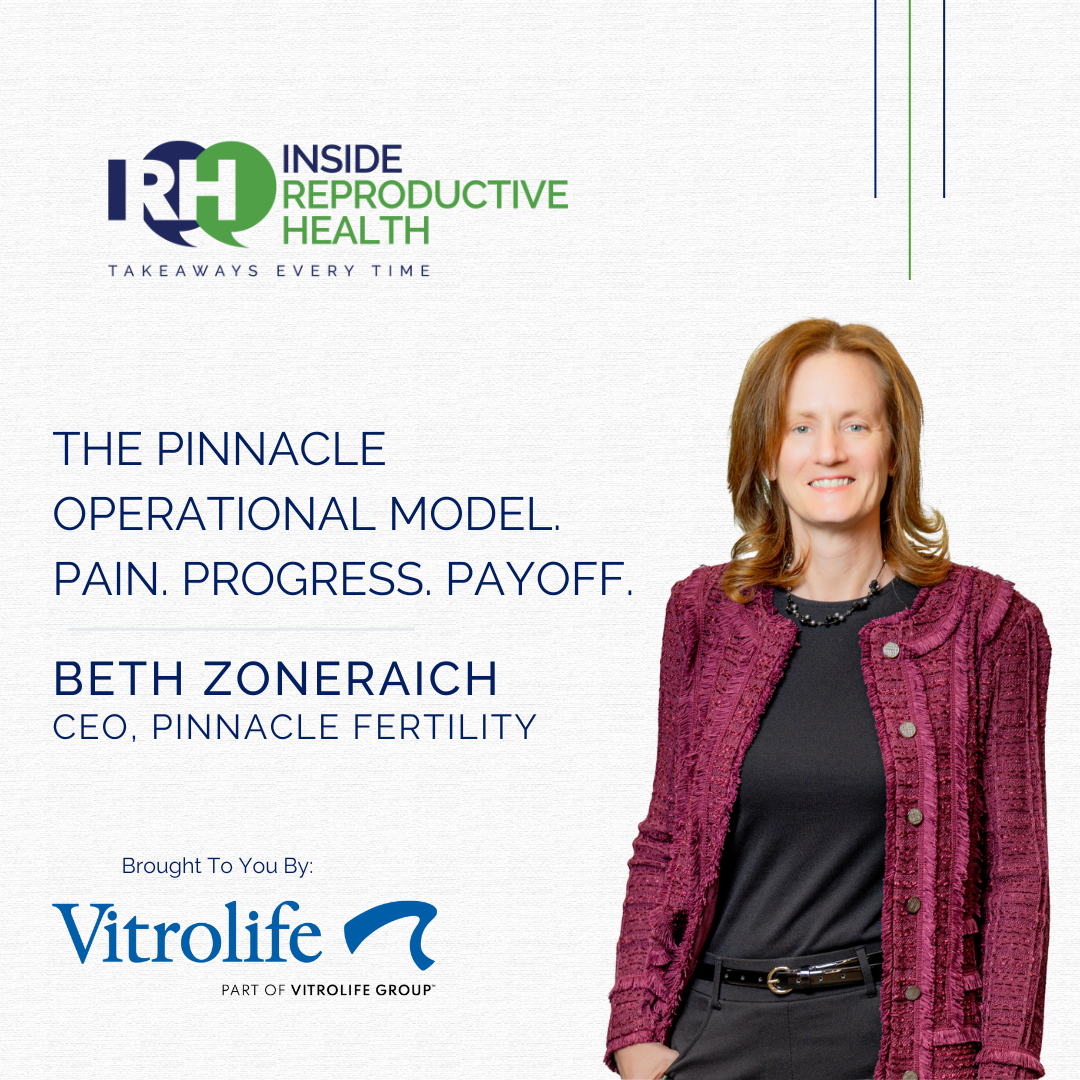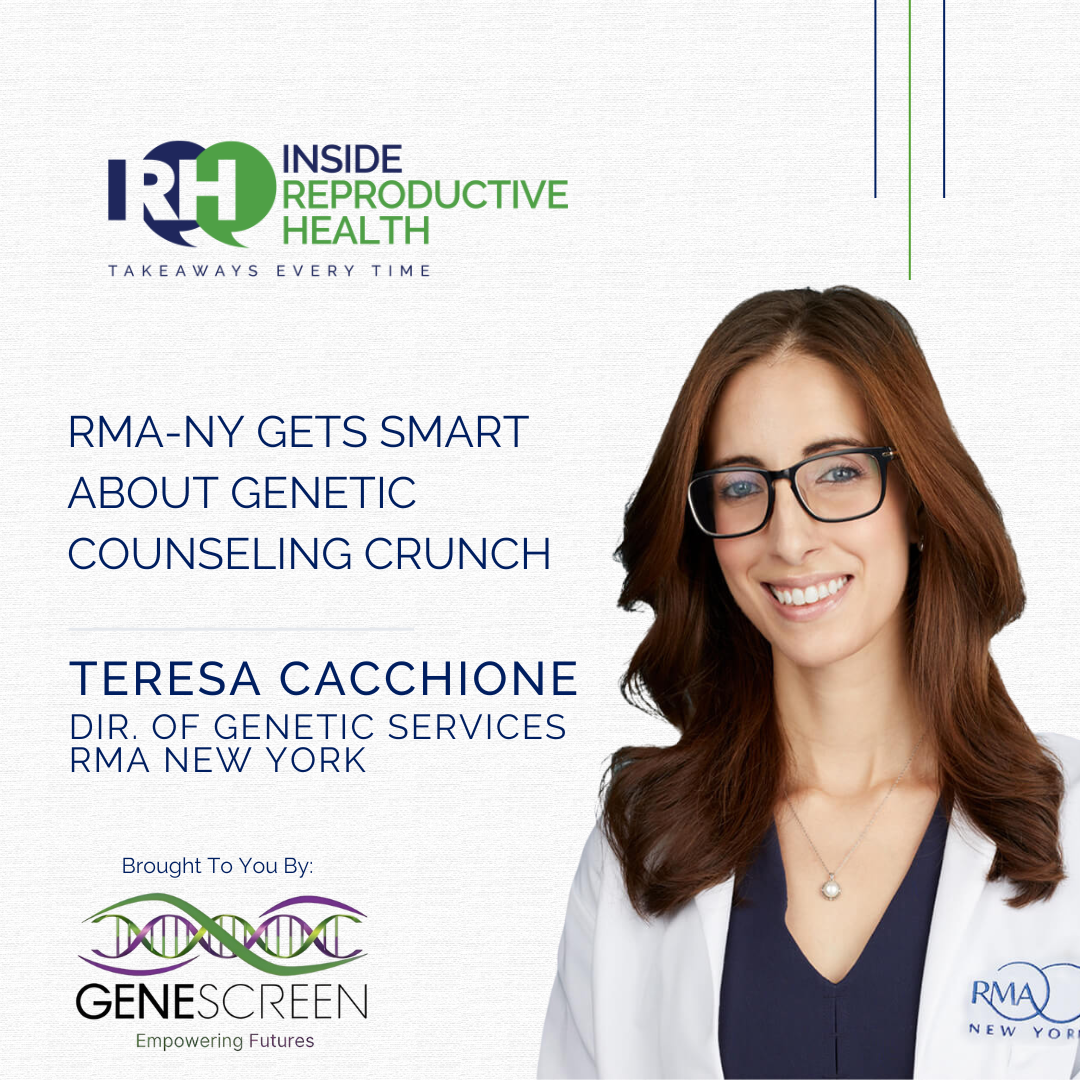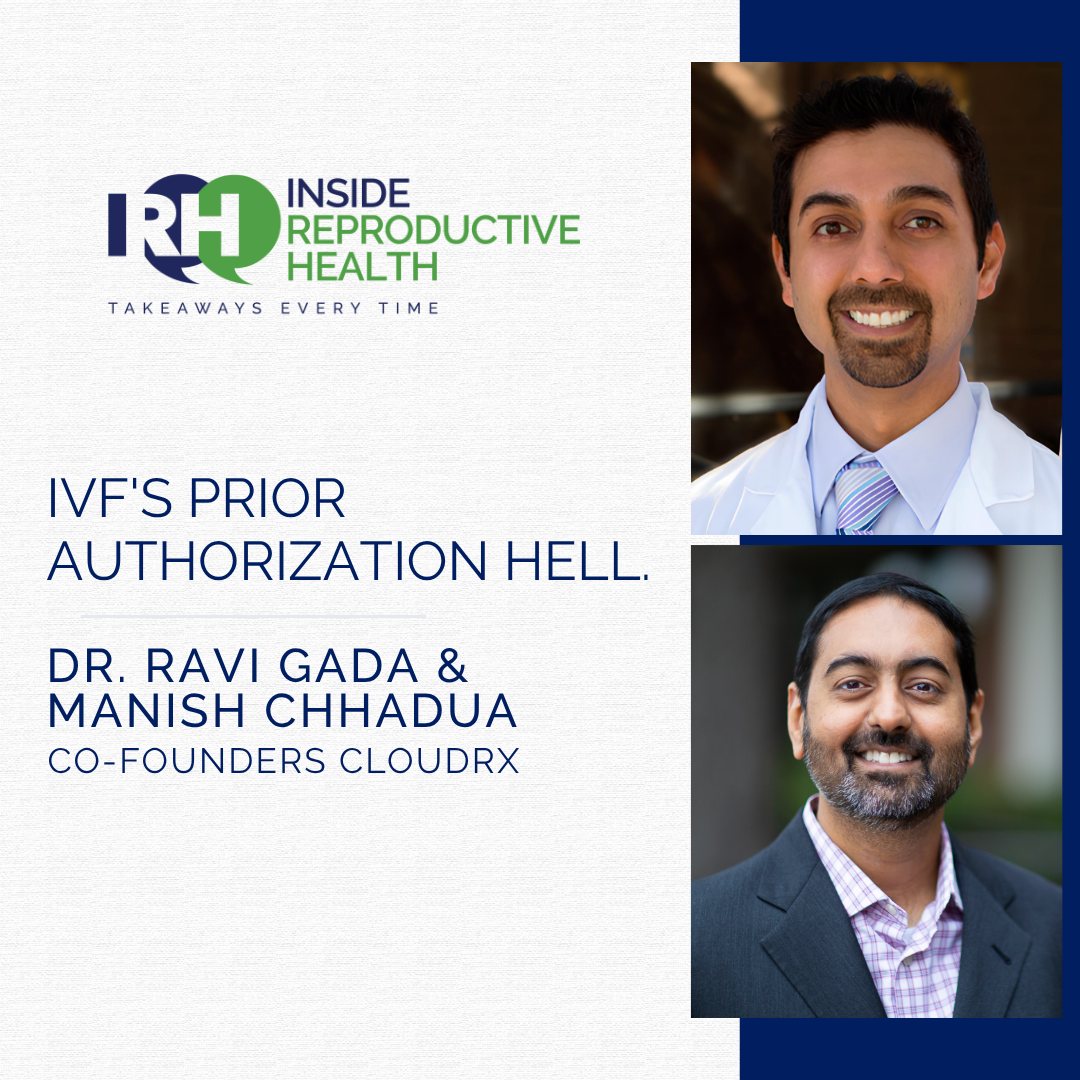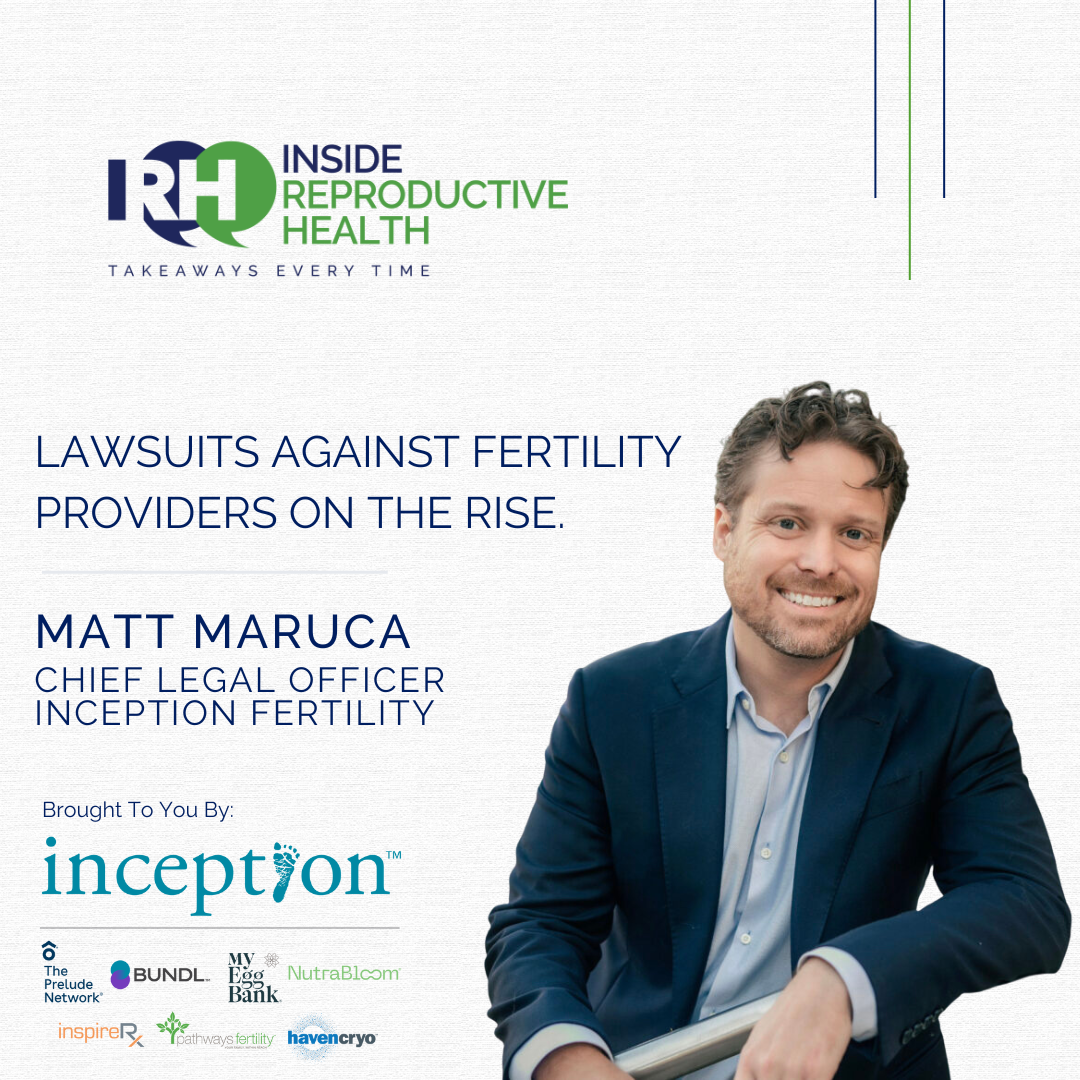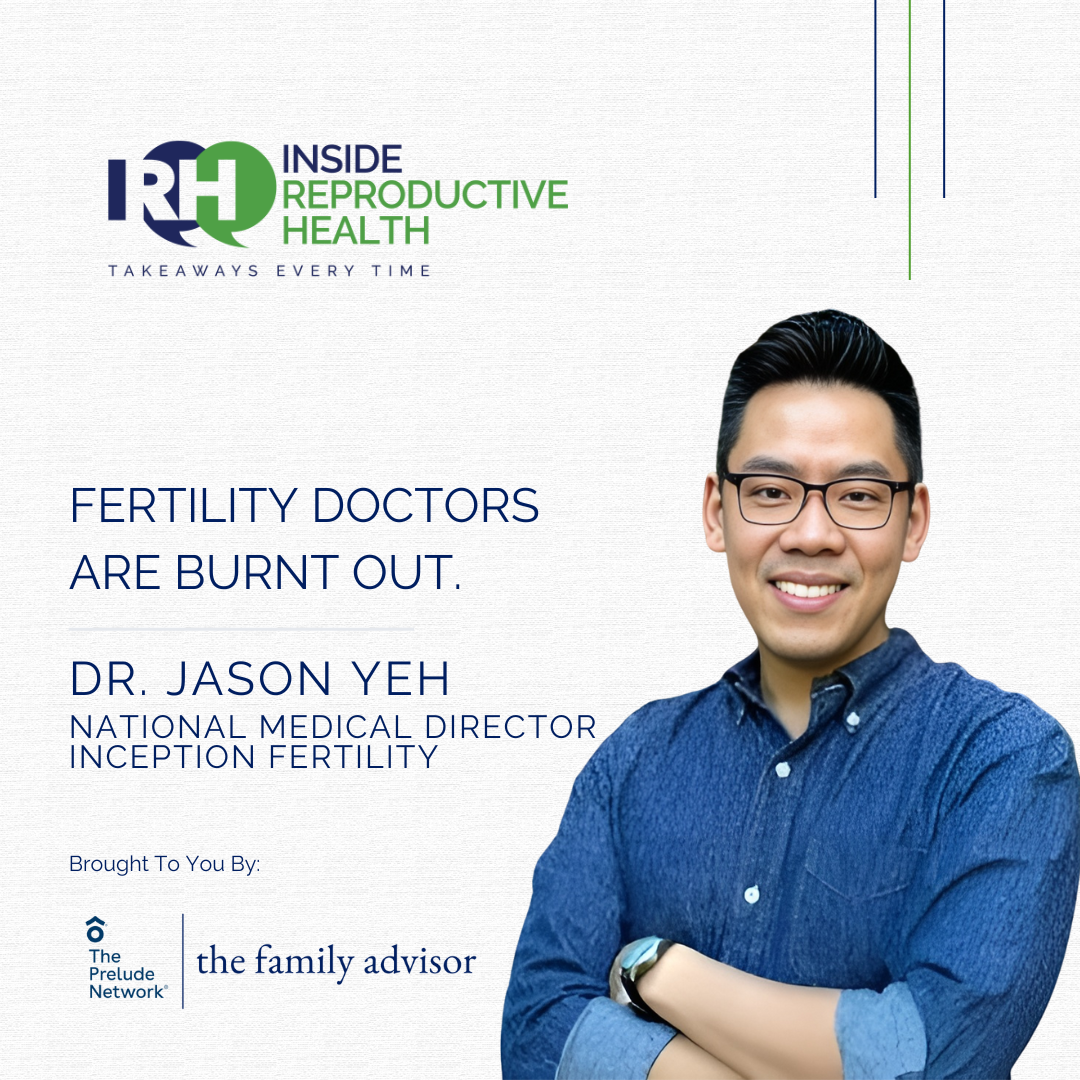Today’s Advertiser helped make the production and delivery of this episode possible. But the themes expressed by the guests do not necessarily reflect the views of Inside Reproductive Health, nor of the Advertiser. The Advertiser does not have editorial control over the content of this episode, nor does the Advertiser's sponsorship constitute an endorsement of the guest or their organization. The guest's appearance is not an endorsement of the Advertiser.
“They expect us to be perfect.”
That’s how Dr. Jamie Grifo, Chief Executive Physician of the Inception/Prelude Network, describes the expectations placed on reproductive endocrinologists from patients, payors, and policymakers alike.
And while perfection may be impossible, preparation and partnership aren’t.
He discusses:
– Why NYU Langone has three in-house genetic counselors in their REI department
– How they counseled over 700 new patients last year
– What led to 300 PGT-M cycles out of 5,500 retrievals
– The challenges of sharing counselors across a growing network
– Regulatory complexities from state and federal oversight
– Why some REIs may be missing key opportunities to help patients with mosaic embryos
Genetics in Fertility Care Means More Than a Test - It Demands a Team.
57% of Patients Had Missed Risks. 42% Changed Clinical Care. 19% of Donors Found Ineligible.
Genetic testing is complex - and interpreting what it means for patients and donors is even more so. Without dedicated expertise, critical family-history and variant insights are often missed.
57% of patients were found to have previously unrecognized genetic or family-history risks, and 42% of those findings changed clinical management (Thompson et al., Am J Perinatol 2020).
In donor screening, 84% of applicants shared new or clarifying health information during genetic counseling, with 19% subsequently found ineligible under ASRM or program guidelines (Varriale C, et al., J Assist Reprod Genet. 2025).
Incomplete genetic review risks care gaps, regulatory exposure, and loss of trust.
GeneScreen delivers concierge-level, comprehensive genetic counseling that integrates seamlessly with your clinical workflow - scalable, accurate, and patient-centered.
References:
Accuracy of Routine Prenatal Genetic Screening in Patients Referred for Genetic Counseling - PubMed
-
James Grifo MD PhD (00:00)
Genetics is one of those things that doctors were trained in it. We understand it, but you really need specialty people and you need resources for your patients and you need to spend a lot of time talking to them and counseling them. And genetic counselors are uniquely suited for that. They have knowledge that's better than ours. And they also know how to counsel patients better than we're trained. And so they become our kind of our right arm helping us with the patient with the problem and solving it for them.
Griffin Jones (00:40)
They expect us to be perfect. I wonder how many REIs would agree with my guess that that's how patients, payers and politicians view them. Probably 100%. And while some of you try to act like you're perfect some of the time, when you're being honest, when it's just your pal ol' Griff here, you know you can't be. Dr. Jamie Grifo is chief executive physician of the Inception Prelude Network, practicing REI at NYU Langone. He's an MD, PhD. He's been studying genetics and ART since the 80s and 90s. And even he turns to genetic counselors for help and has for over a decade. Dr. Grifo shares why NYU Langone has three in-house genetic counselors in their REI department, how they counseled over 700 new patients last year, how their program did 5,500 retrievals, and why 300 of them were cycles with PGTM.
Dr. Grifo weighs the benefits of having counselors at the practice and the challenges of sharing them across the network. He talks about the regulatory challenges posed by different government agencies at the state and federal levels. I talk about how many of Dr. Grifo's fellow leaders in genetics and ART use a company called GeneScreenbecause GeneScreen's, genetic counselors act like in-house genetic counselors, and they help genetic counselors at clinics who actually are in-house. support them. Dr. Grifo shares an interesting point that many REIs might be missing opportunities to help their patients because they can't counsel on the viability of certain mosaic embryos the way a genetic counselor can.If you're interested in the fast pace, whiplash speed, world of genetics and ART. Enjoy this conversation with Dr. Jamie Grifo.
Griffin Jones (03:18)
Dr. Grifo, Jamie, welcome back to the Inside Reproductive Health podcast.
James Grifo MD PhD (03:23)
Great to see you Griffin, thanks for inviting me.
Griffin Jones (03:26)
Why are genetic counselors important?
James Grifo MD PhD (03:29)
Boy. So when I started in this field a long time ago, patients didn't know they carried genetic diseases. They found out by having babies with them. And often we had no tests for it and all we had were really poor treatments for the babies that were born with these illnesses. Fast forward to where we are now. And this was my dream back when I started in this field, the idea that you could find the embryo.
with a chromosomal or genetic abnormality, a gene defect that causes disease, and we could not put those embryos back so we could eliminate the possibility your child would have one of 558 known recessive gene diseases of newborns. That was always the dream and guess what, we're here. The problem is back when I started, medical information, like every 10 years doubled. Well, now I think medical information doubles every two, three months.
And medicine has gotten so highly specialized because within a discipline, it's hard to keep up with everything that's happening. you know, the genetics is one of those things that doctors were trained in it. We understand it, but you really need specialty people and you need resources for your patients and you need to spend a lot of time talking to them and counseling them. And genetic counselors are uniquely suited for that. They know a lot more than we get trained as doctors. And we learn, you know, as we.
as we treat patients, they have knowledge that's better than ours. And they also know how to counsel patients better than we're trained. And so they become our kind of our right arm helping us with the patient with the problem and solving it for them.
So it really is essential that in some way, if you're doing IVF and you're a heavy PGTM program like we are, because I did the first successful.
United States born embryo biopsy in 1992. That's how long we've been doing this. we now with improvements in molecular genetics are so much better. And pretty much if a patient carries a gene that's known to cause disease, our specialty labs can build a probe for it and we can test an embryo for it. And we can prevent that couple who has either a 25 or 50 % chance of their baby being born with a lifelong illness, which is horrible. And we can...
Avoid that by finding the embryos that are healthy and not using the ones that aren't. But, you know, we do a simple blood test on these patients. We get information on what they carry, both partners. They need to be counseled. Genetic counselors know how to do that. Then there's the specific diseases you need to know about every single one. And our genetic counselors know very detailed information about all of them so they can counsel patients. Some of the diseases that we find are not that significant, that you can live
with it, but patients need to know that and we're obligated as physicians treating patients to give them everything we know so that they can make informed decisions about how they want to build their family. in order to do that, you need to be disciplined. You need to have the right support staff. And it was not that long ago, but you know, we used to refer it out to the genetics people, but it's much better having them in our office. We have three genetics counselors now on our staff.
They did 700 consults with patients to talk about genetic issues. They looked at 4,000 carrier screening results and went over them with patients. You can't do that as a doctor. You don't have the time nor the training. So they're a big part of our team. And as you know, with PGT, we also have identified mosaic embryos.
as embryos that are not chromosomally normal eucloid, like the embryos that the majority of which make the babies, mosaic embryos, we now know and can counsel patients on. Some of them have a very high chance of making a healthy baby. Some of them have a very low chance of making a healthy baby, but still can. So we have all this information and it needs to be shared with patients. It needs to be done in a methodical, organized way so that patients are fully informed.
And we've now transferred hundreds of mosaic embryos that have made healthy babies. And many clinics are afraid to transfer those embryos because they don't have the knowledge that our genetics counselors do and we do in our experience. So the world has changed so fast and it's hard for all clinics to keep up. And we're a specialty clinic. did about 5,500. We're going to do about 5,500 retrievals this year. And a big chunk of what we do is PGTM.
mean, we've done over 300 cycles of PGTM in 2024. We're doing more in 2025. It's not complete yet, so I don't have the data. But this is how fast this stuff has caught on, and we have to keep up with it. And you can't do that alone. Not even.
Griffin Jones (08:18)
So that's
a lot of retrievals and it's also a lot of cases. So you got three genetics counselors and you said they've counseled 700 patients. Do you mean this year we're recording towards the end?
James Grifo MD PhD (08:26)
Yeah, 2024.
I don't have 2025 data because we're still in it, but it's more, at least the same or more, those numbers. I just gave you the 12 months ending December 2024. We did 700 internal genetic counselor consults regarding single gene diseases and also, you know, aneuploidies. 300 cycles of IVF were done to test for a single gene disorder.
know, commonly things known like Tay-Sachs, cystic fibrosis, gauches, canavans. But there are some diseases of the 558 I had never even heard of until I look them up. I mean, you find that the couple, each of them carry that 25 % of their babies are going to be born with an illness and that's not good.
Griffin Jones (09:13)
I wanted to ask you about that. Can you think of any specific cases in the last six months or a year where your genetic counselor counseled a patient that you think, like, I didn't know that, or I wouldn't have thought of that?
James Grifo MD PhD (09:27)
Well, I mean, no, because I'm in this specialty field here and this is what we focused on at NYU. It's been my whole career. So I'm probably a little bit more knowledgeable than most doctors, but many doctors, you know, don't know a lot about all this stuff and they need the Gen X counselors to counsel the patients. I mean, we're doing also lot of hereditary cancer genes that are known to be associated with increased risk of cancer in patients, you know, offspring. we can...
you know, find that in embryos and not use those embryos. Things like the BRCA gene, which is the breast cancer gene. You know, it's, and every day new things are being discovered. And, and some families are actually being diagnosed. Hey, we didn't think you had a disease. Now we found the gene and now we can build a test when, you know, a year ago we couldn't. So, and we just have to keep up with that. It's not, it's not easy. And that's where our genetics counselors come in, but
I can name a number of cases where patients came from outside where the doctor read the report and thought that the patient was fine and had nothing to worry about. But when you actually read between the fine print and realized some of these patients were misinformed and a genetics counselor catches those, they're very rare, but we can't tolerate any bad outcomes. have to be perfect, we're expected to be
them are human and no human is perfect. So it's a lot of pressure and it's a lot of responsibility. But you know what? We're here for our patients. That's what it's all about. We're about healthy babies one at a time. Because if we want to build a better world, we got to help parents be parents, especially the ones who want to take it so seriously. And so it's so important in their lives that the world will get better if we help more of these patients.
Griffin Jones (11:15)
So you're so immersed in this field of genetics that there's not necessarily going to be a case that a genetics counselor is going to know significantly more than you or catch something more than you. So to you, you personally, what's the use of a genetics counselor? Why not just do it yourself?
James Grifo MD PhD (11:31)
⁓ I mean, they
definitely know more than me. I know, I know a lot, but they know way more than me. called, I call them up all the time, ask them a question about a specific case and help me look it up. And then they go to the literature and they find what's changed since the last time I read about it, you know, three years ago or whatever it's changed. And I don't know, because I can't keep up with that literature. So, you know, I I have a pretty good understanding of most of the things that we deal with, but it's all nuanced and it's ever changing. And you need people who.
can be a resource and you can send a little text right and they're either across the hall or you walk over with a report and say, wait a minute, what did I tell this patient? And I always have them talk to our, the patients talk to our genetic counselors, because they need that. They need to hear it from me, they need to hear it from somebody who counsels patients with genetic diseases. They know how to speak to them in a different way than doctors are trained that makes them more comfortable and helps them understand risk and right sizes risk.
You know, people get pretty alarmist at times and you you don't want to alarm your patients. You just want to educate them and you want to give them the best outcome.
Griffin Jones (12:35)
RMA of New York got smart about the genetics challenge. What's one of the things they did? They used GeneScreen. Dr. Kate Devine of US Fertility, Dr. Shafali Shastri from RMA, Dr. Deb Keegan from CCRM. They're all leaders in genetics in the fertility space. What's one thing they all use? GeneScreen. If you're a fertility doctor or a clinic owner, you already know genetics is one of those areas that can get complicated fast. Panels keep
changing and patients have more and more questions. Even the best clinical teams miss things. In one review, 57 % of fertility patients had missed genetic risks in routine screenings. 42 % of those changed clinical care. You do not need that kind of legal risk or that kind of risk to your patient. That's where GeneScreen comes in. They provide concierge level genetic counseling that plugs right into your team, scalable, accurate, and always patient centered. Visit
gene-screen.com or ask me and I'll make an intro to them. Those guys are great. That's gene-screen.com. So, Jamie, you've got three genetic counselors now. How long have you had those three? Did you start with all three and build out that program once?
James Grifo MD PhD (13:47)
No, we
started with one and then we added a second pretty quickly and then we added a third pretty quickly. I don't remember the timing of it, we've had Andrea has been with us about 10 years, Andrea Besser, and she's brilliant and incredible. She's probably one of the most knowledgeable fertility genetics counselors out there just because of her experience. And not all clinics can have this level of service. We have the volume to support it.
Other clinics can use outside resources. They work quite well, like you said, GeneScreen. It's just that a clinic like ours, we need it internally. It's more personalized for our patients and for us as well. It streamlines our ability to take care of these patients, but not every clinic can have that kind of overhead to manage it. We just are so busy that it makes sense. So there's lots of ways of doing this. This is just the way we've evolved because we've been
a center of excellence in, you know, PGTM and focused on it. And so we put it in-house. But that's what works for us and what works for others. The GeneScreen works for others. They're all good. You need resources. You need knowledgeable help. And you need somebody who's keeping up with the field because the genetics field is so rapidly changing.
Griffin Jones (15:00)
I know I'm asking you to go far down memory lane, but to the extent that you can remember a decade or so ago, what was the impetus that made you say we need a genetic counselor? Did your colleague physicians also come to you with the same issue? Did you then have to approach the REI division or OBGYN division at NYU? And how did that whole process work? did you, like one, how did you come to the need? And then two,
how did you design exactly what work that they were gonna do so that you could prove it was something of value?
James Grifo MD PhD (15:36)
So we used to refer them to our genetics team here at NYU, sometimes for specific illnesses with other institutions where there's more expertise in a particular gene. But the problem with that is communicating doctor to genetics counselor is quite time consuming, lots of phone tag, and the ability to miss something because of that was just too high. And we just realized, hey, we need to bring this in-house because we're spending too much time.
know, coordinating care and we should just have, we have enough volume to support it. It's better for the patient. It's faster. We get them in really quickly because it's our team supporting our team and we don't, you know, not supporting multiple teams. So it makes for a better patient experience. It makes for a better doctor experience. It also, we're double checking each other. We're constantly in contact with each other. We're in the same office. That's an advantage. And you know,
I can call them anytime I got their cell, they got my cell, they can call me when there's a problem. It's just a lot easier than using a third party referral service, but that works well for most centers because most centers don't have the volume that we have. When you have the volume we have, we need it in-house and that's how we got there. And no, I didn't need to ask permission. I'm the division director. I presented a meeting to our team. said, Hey, look, we're going to do this. We have this person. She's going to be great.
And everybody said, wow, thank God that's really great. You know, this is really hard calling genetics and waiting to hear and then having to go back and forth with the patient and talk to the patients. And I don't really have the training to be a genetics counselor. We need somebody in here. Everybody agreed with it. you know, it was an expense that we pay for and we think it's worth it. It's built into the infrastructure and, you know, our volume, you know, allows us to do that and it makes it affordable for us to do that.
And then again, it's really about the patient. You you can do things in simpler ways in many cases. I didn't get into this field to see how many corners I can cut and how easy I can make it. want to be the best we can be. This is a group of people every day come to work trying to get better because our patients deserve it, our field deserves it, we deserve it. And so having that in-house has really, really streamlined our genetics. And also,
What happens then is we train residents and fellows. They interact with them, that we've written some scientific papers because of our clinical experience with them. So it allows us to reach the younger doctors to be in the future and get them really involved in it. So it's really a win-win-win. The patient wins, we win, the program wins, and our specialty wins. So that's what we're about. And that's why we do it the way we do it. And it's been really great.
Griffin Jones (18:23)
Of those 700 cases counseled last year, for instance, very generally, what's the breakout of PGT versus carrier screening?
James Grifo MD PhD (18:31)
So, I mean, we did over 4,000 carrier screen consults discussing and reviewing. So the 700 internal genetic consults are a combination of, know, aneuploidies, mosaicism, and pre-implantation genetic testing for monogenic diseases, and then also the translocations, the structural rearrangements. So it's a mix of all of those. The majority are
Aneuploidy and mosaicism, a big chunk are single gene disorders, PGTM, and a small fraction are the translocations, but they are really significant. Those patients have recurrent miscarriage, they have pregnancy losses, and until you diagnose that and are able to find the balanced embryos, those patients struggle and suffer. So they're probably the smallest component of that. But you need expertise in all of them, and that's what our genetics counselors have.
Our experience, you know, because we see so many different things, we're a tertiary care center, we get the referrals of the complicated cases. Because of that, we're constantly being retrained and improved every day just by what happens and what the patients that we see. And that's what you have to do in medicine these days. Things are changing so fast. You have to be nimble and you have to be quick. And when you have people right down the hall, you're nimble and quick. And that's good for patients and good for us.
Griffin Jones (19:50)
Why not just use the counselors from the genetics labs? They've got plenty of good counselors, the different carrier screening labs out there, for instance, and I think the PGT labs do too. Why not just use those folks? Why have counselors in-house?
James Grifo MD PhD (20:10)
So because the counselors in-house are more responsive to us, not that the others aren't, very responsive, but not only that, they're longitudinal. So they're here all the time. So the patients bond with them and know them and get comfortable with them. They do WebEx's with them and meet them. And so they want to talk to specific people. They're comfortable because they trust them. They build a level of trust and caring and empathy that you know.
It's not so easy when you're a reference lab and talking to thousands and thousands of patients, we're just one center. So I think those are, you know, just things that we like for our patients to make their experience with us better and more, you know, patient friendly and comfortable. Cause you know, there's a lot of discomfort when you're talking about genetic things and anything we can do to take down the temperature and take down the worry and, build trust and help them understand. We, we know what they're going through and what, what it's like to be them.
how to help them build the family that they want safely with good outcomes. If you're gonna be a comprehensive care center in this field, you gotta do that. So that's why we've chosen to. it's not for every clinic. You can't support the infrastructure. We do because it's worth it to us and we wanna spend the money on it because it's worth it for our patients.
Griffin Jones (21:24)
you've made the patient experience argument for having in-house genetic counselors. Is there also a quality of care that, are they able to address the patient more holistically than a genetics counselor from one of the labs? And why or why not?
James Grifo MD PhD (21:42)
Yeah, because they have
our chart. They have our experience with the patient. The patient's already spoken to us, so they know the whole conversation when they talk to them. They're already familiar to start. And then they're in constant contact, because it's not a one visit thing. You have a lot of contact along the way. And having continuity of care and talking to the same person is really powerful for a patient, because
They don't have to tell their story all over again to a new person and wonder if they can trust them like the first one they spoke to. And it just takes something that's very hard for patients and makes it a little more palatable and a lot more user friendly.
Griffin Jones (22:19)
Do insurance companies sufficiently cover this?
James Grifo MD PhD (22:23)
No, no, we
eat the cost. It's just because of the way it's structured and the way we do it, it's just, you know, it's just, we build it into our infrastructure. It's just worth it. It's an investment we make in our program for our patients benefit. And I think it's one of the reasons we're successful because we do those kinds of things.
Griffin Jones (22:44)
Is that more because of the way that you all do it and want to do it? is that something that's insufficient from the fertility carve-outs and insurance companies?
James Grifo MD PhD (22:56)
I don't really even know to be quite honest, because I don't really get to that level of detail around that stuff. It's just that I think you have to have a specific genetics counselor MD trained who's going to be, you know, signing off on all the charts for the insurance companies to, you know, reimburse and they just don't reimburse genetics counselors at the same level. And so it's just, you know, when we need an MD
Genetics counselor, we use them and the patients go see them and they build them separately. for what we need to do, we don't need to do that very often. So we just keep it in house and do it. It's worth it. But not every clinic can afford it. But you have a volume like we have and you have the volume of patients with these issues that we have, it's well worth it.
Griffin Jones (23:42)
Tell me about their workflow. How does their workflow integrate with yours? At what point does a patient go see one of your genetics counselors and in between what kind of visits and then how do they interact with you, interface with you, interface with the rest of the care team? Tell me about that.
James Grifo MD PhD (24:02)
Yeah. So for instance, I just saw a patient in office today who I'd done a WebEx, you know, an hour long talk and they carry, you know, to they carry the same recessive gene and they came to me and we spoke about it. I saw her like two weeks ago initially on Web. And today I saw her in the office for the initial visit and ultrasound and all the other stuff. She'd already seen my genetic counselor the day after I spoke to her.
There's a whole note in the chart that I can read and know and the patient knows and that's all sent to them. And so it's very patient oriented, patient friendly. And then we're familiar with each other too. I mean, when you're a doctor, you work with familiar people, there's a level of understanding and a level of familiarity that also makes us more efficient and makes errors less likely and makes
you know, problems less likely. And so, yeah, they're right down the hall. If I need to talk to one right now, I just walk there. They're not always here every day. They do a lot of stuff for moat. But I have access to them and they have access to me whenever it's necessary. And I think that really is how it works. As the patients come in and need consulting, I mean, they're busy. That's why we kept adding genetic counselors. Their time gets filled. There's always patients that want to talk to them about their embryos.
about which one they should transfer, what about this mosaic, what's gonna be the outcome, what can I expect, what are the risks, what would you do if you were me, if this was your family member, those are kind of questions patients need to be able to ask and feel comfortable with. And it gives us a level of security as physicians knowing that we're providing a level of care. mean, it's just, you know.
It's accurate, it's intact, we don't have to worry about missing things and having a baby born with a problem. Because forget about the lawsuit, that's awful. The baby being missed is worse for everybody, especially the patient. So we're very mindful of that. want to make sure patients have best outcomes and that we have tremendous amount of pressure. I don't think people realize how hard our job is in that regard and how many things can go wrong in an IVF clinic. And we're expected to
to be perfect and like we're human, no one's perfect. We do an incredibly good job because you have built-in safeties, this is one of them. Having your genetics counselors at your disposal in your office is a safety and so that's a big part of it. And they're busy all day doing consults with patients, talking to us, talking to the genetics labs, organizing, know, how do you get your probes made? They interface and make us more efficient with the reference labs and the genetics counselors at the reference labs.
and they're very friendly with them. they're a resource for us. We're a resource for them. So it benefits the labs we work with. It's just a win for everybody. so, you know, some things are just, are worth it, even though it's a sacrifice and it does cost money, but it's just worth it.
Griffin Jones (26:59)
Did you notice a difference when they're remote versus when they're down the hall? suspect during COVID they were remote a lot more frequently.
James Grifo MD PhD (27:04)
Well, but there's
always one here. So if the other two are remote, there's always one here. So that's not a problem. But when I say remote, I just pick up the phone instead of walking to our office. It's not hard. Let me get back to you really quickly. So no, COVID was a unique situation. We, as you know, practiced during COVID despite the SRM saying we shouldn't. And we couldn't do that. Our patients are old and waiting was not going to help them.
You know, through the FPA, all of, actually some of our most fiercest competitors, but, you know, fierce friends too. We all got together and made protocols of how do you practice? How do you help your patients in the middle of a pandemic? And we came up with procedures and protocols. Cause when you have the SRM saying we shouldn't be doing it, we're really out on a limb. And we all came up with agreement about how to do it. And we even published the paper. did 1400 cycles during COVID.
And in New York City, where 1,400 people you would have expected 100 to 150 of them to get COVID, two people got COVID. And our patients who got COVID, we said to them, we'll do a free cycle. If your cycles cancel with COVID, you'll pay for the drug. We'll do the rest. And those two patients had a cold. They were at home in bed. They weren't hospitalized. None of our staff got COVID. And we demonstrated that you could do this safely. And when you're highly motivated not to get COVID during a pandemic because you're doing your cycle and you know,
It's amazing how effective that is. And we proved that, we published that. Unfortunately, the SRM never really recognized it, but it is what it is. We're set up for the next pandemic, because there will at some point be another pandemic. And we now have demonstrated a safe way to do that. And yeah, our genetics counselors were off site that whole time, but they still were talking to patients. They still were helping us. We had minimal staff in-house just to keep the risk down.
It's amazing how efficient you can be with remote. I mean, it's like I'm talking to you, you're how many miles away. It's as if we were sitting in the same office. So it works.
Griffin Jones (29:07)
What are the most common questions that your genetic counselors get and what are the most common questions that you have for them?
James Grifo MD PhD (29:15)
So, you know, how do I counsel this patient on this thing that, you know, she carries hemochromatosis, what should I tell her? And, you know, it's an autosomal dominant disease in many cases, and, you know, half the embryos are going to get it. And, you know, you can live with it, people do. And, you know, that's where the genetics counselors are really powerful because they go through all the manifestations. Because, you know, you have a gene disorder, every patient expresses it differently. And, you know, some people can have very
unperturbed lives with a genetic illness and some can be absolutely devastated. And you can't predict which now allows us to help patients not have to be in the middle of that we can avoid it completely. Congenital adrenal hyperplasia which people live with and many people have and do fine. When two carriers show up they're motivated to not have their child have it because they're living with it they know what it's like.
know, mom's had breast cancer and you carry the BRCA gene and you're going through all kinds of treatments, knowing someday your ovaries are going to be removed. Someday you're going to have a mastectomy. You're going to have a healthy life and not get breast cancer. But you got this gene that's really interfering with a lot. You don't want your child to have it. And, know, how, you know, how do we test for it? How do we, you know, what about the male embryos? What's their risk? And, you know, there's, there's all kinds of things that come up and, know, each individual disease in and of itself is a study.
know, cystic fibrosis. Some patients get really severe form and it's really awful and some don't. But the reality is you can't predict what's going to happen. We really counsel patients not to, you know, have that or have a baby with that. So we do our best to prevent that. it is, you know, every day is a journey. Every day is an adventure.
Griffin Jones (31:01)
Every day is an adventure just like the rest of the fertility space and genetics because genetics and fertility care isn't just about the test. It's about what happens after. That's why other top clinics, Army of New York, CCRM, US Fertility, they all trust GeneScreen because even the best teams miss things. In one study, 57 % of fertility patients had genetic or family history risk that went unnoticed. And then when those were found, 42 % changed clinical care.
In donor screening, nearly one in five were found ineligible after proper genetic review. That's the difference between confident care and costly gaps. And when these other people are using GeneScreen, they're people that some of them don't have in-house genetic counselors. Many of them do. And GeneScreen's, genetic counselors work with their in-house genetic counselors like they are in-house genetic counselors, like they're an extension.
of their care team, or at least that's what they'll tell me. GeneScreen gives your patients and your team what off the shelf testing can't. Expert genetic counseling that's seamless, scalable, and built to protect your program from risk. They don't just run reports, they see what others might miss. Find out why the leading fertility clinics and networks are choosing GeneScreen. Visit gene-screen.com or reach out and I'll make that intro. I'll be happy to do that. Gene-screen.com.
This might be a dumb question, Jamie, but could networks share genetic counselors so that they're covering multiple different practices or, didn't in house genetic counselors, should they really be embedded at the practice level?
James Grifo MD PhD (32:41)
Well, I mean, there's definitely advantages being embedded in the clinic just because of all the reasons I discussed. You certainly could do this on a network basis. And it's just a big task. then how do you pay for it is a problem that needs to be addressed and is addressable. It's just a matter of
doing that. But, know, Hannah Green, one of our genetics counselors, the second one we hired, Andrea Besser was the first and Carissa Eubers are more recent one. I mean, they've all given amazing talks at ASRM. This year, Hannah gave a great talk at ASRM talking about, you know, some of her things that happened last year where we picked up things that were missed by, you know, patients who came to us from other centers who had their carrier screening done and they were they they were told that everything is okay.
and everything wasn't okay. One was a translocation case with a normal karyotype, which is easy to miss in those circumstances. One was a thalassemia case that was misinterpreted. One was an SMA, spinal muscular atrophy case, one of the most common genetic disorders that we see even more so than cystic fibrosis. And so, you know, they saved these patients from a lot of problems by, you know,
the type interaction that we have. So that's what we do. That's what GeneScreen does. And we're happy with our system. We built that. It's been 10 years in the making. And it works.
Griffin Jones (34:15)
Have you made that case to your network to the prelude network? Have you made a case for hey, let's, let's replicate what we've done here at NYU and let's have more in house genetic counselors and let's share them together? Or have you been more focused on what you've got in your program?
James Grifo MD PhD (34:32)
Yeah. I mean, the problem with being across state lines is, you know, WebEx, unless you're licensed in every state, you can't do that. And so, you know, it's, you don't have a license to practice in other, other places. And, you know, some of the obstacles are more regulatory as opposed to like, Hey, let's just do this. And, you know, unfortunately the people who make the rules have no clue of what we do in the office. And they make rules that sound, you know,
smart from their angle, but they don't realize how much harm they cause. The unintended consequences of untrained regulators is probably one of the biggest hazards we have in medicine. And no one's willing to address it. No one's willing to deal with it. And it's really a shame because it probably drives the cost of care. And hopefully someday somebody in the regulatory space is going to start to address those problems. that's
That's unfortunate. that's one of the hurdles that we would have to do if we gonna do this on a network-wide basis. How do you have somebody in one state be talking to patients in another state and not having cover for that and not having license for that? It's very complex. I imagine GeneScreen has got license in every state so they can do that, but that's cost prohibitive for us.
Griffin Jones (35:43)
I know I'm kind of putting you on the spot asking you to think off the top of your head, but are there other regulatory challenges that you come into contact with fairly regularly with regard to genetics?
James Grifo MD PhD (35:57)
Well, I mean, New York State Department of Health regulates everything here in New York. So, and they don't really interact with like the FDA or the CDC. you know, it gets really complicated because they all have different ideas about how to do things and they don't always, they're not always consistent. you know, genetics is one of those areas where you're going to see inconsistencies. So that makes our job more difficult because at the end of day, we practice in New York, we have to answer to them first.
And then if what New York State is telling us to do isn't in line with what the CDC or FDA is saying, that we have to somehow get through that, it's really a lot of work. But it's all one thing. Well, mean, just how you report things, how you talk to patients about things, how you record them in the chart. And it's minutiae, but it's necessary minutiae in order to practice in a regulatory environment.
Griffin Jones (36:37)
What do they have different ideas about?
James Grifo MD PhD (36:55)
It's all well-meaning. Everybody wants perfection, but it's hard to regulate perfection and litigate perfection. And it's just, you know, it's part of life. It's just some of the frustrations that we have trying to make things better. But, you know, we do our best and we help a lot of people. That's really what it's all about anyway.
Griffin Jones (37:14)
You
talked a little bit about mosaicism and having genetic counselors that can counsel on when it might be viable to transfer a mosaic embryo. You know that you're talking to a non clinician here. I think you know that I'm not qualified to give first aid to a paper cut. So help me understand our other centers. Are they are they missing out on
James Grifo MD PhD (37:36)
Sure.
Griffin Jones (37:42)
a number of patients that they could be helping because they don't have genetic counselors to help them navigate that challenge with mosaicism and help me understand the challenge.
James Grifo MD PhD (37:53)
Perhaps,
yeah, perhaps. I think a lot of people are risk averse, you know, in practice doctors are really afraid of getting sued. And so some of them are unwilling to take risks, which we have to take every day. In the old days of IVF, we didn't know mosaic embryos were being transferred. I did, because we published it in 1994 that about 20 % of embryos had evidence of mosaicism at the eight cell stage.
No one knew what to do with that publication. actually was rejected four times because no one believed it. And the fifth journal finally let us publish it. And it wasn't until we started doing PGT-A with next generation sequencing that it became very clear that there were a lot of embryos that had abnormal cells along with normal cells. And that's really what a mosaic embryo is. And the reality is probably every embryo has abnormal cells in his mosaic, but the level of mosaicism is below 20%.
our test doesn't even pick it up. We call it euploid, but there's a reason why only about 63 % of euploid embryos make a baby, because sometimes the abnormal cells take over and you don't get a baby. With most mosaic embryos that make a baby, the euploid cells take over and you get a baby and you never knew there were abnormal cells. And so be it with mosaic embryos, not knowing we were transferring these for all these years before we had this test, the baby was born, the baby was healthy, no one knew it started as a mosaic embryo, we did.
And that's why when we started finding them in our PGTA platform, we didn't discard those embryos because we knew they had potential. We just didn't know. And then what we did is as patients had nothing in the freezer except the mosaic, we said to them, look, we think this embryo could work for you. Here's what we know. What do you think? And the patients said, you know what? It's my only embryo. If I don't transfer, I'll never have a baby. And some of them didn't. And then we started realizing that
There were classes of mosaic embryos, depending on if a whole chromosome was missing or extra, or if a piece of a chromosome was missing or extra in a percentage of the cells. And if it was a low percentage versus a high percentage, we now have a whole data set, internal data set, where we can say, okay, this mosaic embryos is a low level segmental, meaning a small segment of a piece of this chromosome is missing.
in 20 to 40 % of the cells, meaning 60 to 80 % of the cells are euploid. And if those cells take over, you'll get a baby. In our experiences, we put that embryo back. It does as well as a euploid embryo. And we needed to transfer enough of them to find that out. So those, we have very low threshold for transferring. Patients have had amniotes. No one's had an abnormal amnio from it. They have healthy babies from it. We usually put embryos back one at a time. So now we can say to a patient, hey, yeah, this is mosaic, but.
This is really like a euploid embryo in terms of how it performs. You can use this embryo. Now you have an embryo that you wouldn't necessarily use because you're afraid of the word mosaic. we're like, wow, we have lots of mosaic babies or embryos from babies from mosaic embryos who are not mosaic, they're euploid because that's what happens to those normal cells take over. But, know, at the other extreme is 40 to 80 % of the cells are missing or have an extra whole chromosome. Those are called whole chromosome high level mosaics.
about 13 % of them make a baby and about 66 % of them miscarry. So how did we find that out? Well, patients said, look, it's the only embryo I have. I'm willing to do the transfer, help us do this, we'll help, we'll follow you, we'll make it, we'll carefully follow you in pregnancy. And some patients want those embryos because it's their only chance and they're willing to take the 66 % miscarriage rate. Most patients are like, no way, I'm just gonna do another retrieval, but they at least get to make the decision.
In the old days of IVF, patients didn't even know they were making those decisions. We didn't either. We were just transferring these embryos, not knowing, I'm sorry, your embryo, you miscarried. that's terrible. That's nature. Too bad. You know, guess what? It doesn't have to be too bad. You played embryos miscarry 9 % of the time. You know, my 40 year old women miscarry 45 % of the time if they get naturally pregnant. Who wants a miscarriage? Like it's a big value point for a patient not to have a miscarriage, not to lose a pregnancy, not to lose three months of precious time when they're that age trying to build a family.
So these technologies help us give our patients more information. And yes, some embryos that could have made a baby aren't transferred, but that's by the patient's choice, not because we're telling them what to do. And people don't understand that. They just criticize us. They don't understand because they're not here seeing the interactions with us and the patients. The patients do. That's why they come. They get it. They understand how hard we work for them to help them. The critics outside don't get it. They all, shouldn't be doing that. You know, it's not perfect. It's not 100 % accurate. Nothing is.
Mother nature isn't, but we're better having less miscarriages. We're better avoiding an amniocentesis being abnormal since we started doing PGTA with next generation sequencing in 2011. We haven't had an abnormal amnio since then. In IBF with unscreened embryos, used to have in 40 year old women one or two per hundred babies. That was awful. You get to 16 weeks pregnant and terminate a pregnancy. That's not being a good doctor.
when you have a technology that prevents it. So, you know, the critics of PGTA, they have to reconcile that with the patients because that, it's not, the PGTA would never be perfect, but it's better than what we're doing without it. And, you know, you have to know how to do it. You have to have a lab that supports it. You have to have a ability to culture embryos. You have to have a really good reference lab that tests your embryos. And it's well worth it. Having singleton pregnancies, low miscarriage rates and no abnormal amniotes.
And then in the process, screening these patients for 558 recessive genes and allowing them not to have babies with genetic illnesses is kind of a goal. Like you want your patient to have a healthy baby. You want them to have one. It's safer. You want them to not miscarry. It's awful. You want them to not to get 16 weeks and have a problem and have to make a tough decision because it traumatizes them. And this technology does that. And you need genetic counselors to support how we speak to them, how we talk to them about these embryos of mosaics and
and the aneuploid embryos. And so that's why we have it.
Griffin Jones (44:00)
In the absence of those genetic counselors, do think it's often the case that REIs would just say, you know, that's mosaic, let's just do another retrieval? I'm recommending that we do another retrieval as.
James Grifo MD PhD (44:11)
Yeah, yeah, I think
people do because the doctor is afraid to take the risk. And I understand that because lawyers don't get nature being imperfect. They just think everything should be perfect and no patient should have a bad outcome. And they try to litigate away the errors of Mother Nature and then put the blame on us so they can, you know, compensate the quote victim of Mother Nature. So doctors are in a bad position and nobody's protecting us.
You know, we just have to deal with it and live with it and, have those lawsuits and have to go to court and all this stuff. And it's just, it's terrible actually, because we didn't do anything wrong. All we did was let nature do what nature does and we get blamed for it. And it's, and so, yeah, I think that's a lot of it is people are afraid of that. I get that. I understand that. and the patients are afraid of it too though. Like I don't want to take any risk. Give me a less risk. I'll do another retrieval. It's worth it for me to not worry about.
the other, you know, that too. So there's a lot of complexity in it. And, know, like in a sound bite, you can't really have a conversation, but this is why I love podcasts. Cause you can actually help people understand that everything isn't black and white, that there's gray everywhere and we have to manage it. And the only way you manage it is you put the patient first among everything. Cause that's what matters most. That's who we are here to serve. That's why we do what we do.
⁓ and live with the consequences of all the things that another nature throws at us and all the heartbreaks and heartaches because we suffer them too when we see our patients, you know, have a bad outcome and we want them to have the best outcome and that's why we keep, you know, trying to move the needle and get better and do newer better things. So we'll keep doing that.
Griffin Jones (45:48)
Well, neither you or I are lawyers and we're sure as sherbert not giving legal advice, but I might suspect that genetic counselors are in a better position to give informed consent when they are to inform the patient. So the patient has informed consent when they do make those decisions. Because the to your point, it's not perfect, it requires some explanation. And I just have a hard time seeing most REIs
having the time and the frequency of interaction to be able to counsel the patient like that.
James Grifo MD PhD (46:24)
Yeah, and that's why GeneScreen is a good thing because not every clinic can do what we do. So that gives them, you know, the opportunity to have, you know, experts in their corner to help them. And then that ultimately helps the patient. So, you know, there's not one size fits all way to do things in our field and clinics have to play to their strengths and, you know, fill the gaps with other things that can, you know, offer the service that patients need to have a good outcome. ⁓
It's great that there's opportunities and options and that doctors have the resources available to us and patients too as well so that we can give our best.
Griffin Jones (47:01)
In the big old field of genetics and genomics, what research are you excited about and paying attention to right now?
James Grifo MD PhD (47:09)
Just learning how to be more accurate with PGTA testing and we're reaching a level of accuracy that's phenomenal. Everyone was worried about aneuploid embryos, some of them making babies, but if your threshold for your test is set right, we haven't had a baby from a transferred aneuploid embryo. Yes, we transfer them because patients think from what they read on the web that they can make babies. We've transferred a bunch and none of them has made a healthy baby.
Richard Scott even did in his non-selection study, transferred 106 anti-ploid embryos, get a baby out of it. We got a lot of miscarriages. We transferred 35. We got a lot of miscarriages. So now we can have a data set to say to patients, look, you don't want to transfer this embryo. If it's one out of 135, is that a good enough number to justify the 40 miscarriages that you get from those 135 transfers? Do you want to spend the money on a failed transfer and waste it?
and waste a month in a futile cycle. And, you know, it's really helps patients make better decisions and not suffer more than they already are suffering. so, you know, making that accuracy better is, you know, to me, one of the most critical things, something we've been working on for my whole career, really. And it has gotten better. And so, you know, in collaboration with the genetics, different genetics lab providers, we've helped them
up their game tremendously and that's been a really big win for everybody.
Griffin Jones (48:36)
What segments of genetics and art would you like to see more research? If there was younger REIs, younger geneticists listening to this interview right now and you were giving them advice on here's how you make a name for yourself, where do you think you'd like to see more research being done?
James Grifo MD PhD (48:58)
Well, I think, you know, the area of being able to manage particular genes that result in higher risk for inheritance is a field that has a lot of potential, a lot of work and needs a lot of validation. And, you know, that is a real tall task, but if those tests could be validated to the level of, you know, security that they're accurate, that would be a really great thing.
except it's also very complex too, because what if your only embryo has a little bit higher chance of having a heart attack than, you your other embryos that aren't, you can't transfer it because they're aneuploid. You know, do you do another retrieval for that? Or you say, well, you know, this person can eat better and live healthier life and not have the risk of heart attack. You know, do you really want to select for that gene? You know, that's going to be an ethical quandary and also a challenge because how do you explain it to patients so they understand it to the level that it's going to, you know,
not cause more anxiety than, know, because we can't control everything. So, I mean, that's an area that's really ripe for a lot of study and research and finding out a path that's going to be most effective that causes little harm, but great benefit. And that's always the challenge. There's always a balance of those two. You know, people not knowing things and not worrying about things takes away a lot of anxiety. That's a good thing. People knowing too much
puts in a lot of anxiety because you start worrying about all the things that can happen even if they're rare is a challenge too. How do you manage that? How do you manage your patient? How do you give them safety and security? We have no certainty. We have to live with it. It's life. It's the real world.
Griffin Jones (50:34)
I really appreciated when you emailed me because you're very proud of your program. You're very proud of the genetics counselors that you work with. And it was clearly in the best interest of the patient. I you've said we're not getting reimbursed or at least not reimbursed enough. I don't care about that. It's the right thing to do. We have to do it for the patient. So I really appreciate when you shared that with me the first time and then throughout this conversation.
What would you want people to know about your program and the people that you work with?
James Grifo MD PhD (51:06)
Well, I'm really proud of our genetics counselors. I see how hard they work and how hard they try to help patients reach a level of comfort that they can feel secure in their choices. And it's they're amazing individuals. They, every time I listen to them speak, you know, like the conference, was a whole thing, Carissa gave a talk about segmental embryos and the way she described how she talks to the patient about it.
was just so refreshing to see that, you know, these young, newly trained, really smart people are going to make us better, make the world better and make it all the whole specialty better. And yeah, I'm very proud of them. And I'm glad that we could, you know, give them the opportunity to, you know, really hone their skills and see how good they can become. And that's really, you know, we all try hard. We want our best outcomes for patients. Life brings hardships and
things don't always work out and there's lots of heartbreak, but there's about 20,000 babies out there our 30 years of effort has resulted in and that's changed the lives of so many families and so many people. And that's why we go to work every day. Cause who gets to say you do that when you go to work every day. It's really, it's really cool. It's high stress, high anxiety from our part. There's a lot of pressure on us. There's a lot of heartbreak when things don't work out, but at the end of the day, you know,
making a difference in people's lives is one of the most rewarding things you can do. And so I have a team of people who think like that every day, who come to work every day, like, how can we do better? How can we get better? And you do that for 30 years and you get, can, you we have, we got a long ways to go still, but you know, we'll just keep fighting for that. And then my, all my new young docs, we trained and they're, they're awesome. They're incredible. I mean, if my daughter came to this clinic, any of my docs, I'd be thrilled that.
she was seen by them because that's the kind of people they are. many of us have been infertility patients, have experienced it firsthand, what our patients go through. Some of us talk about it, some of us don't, but it really helps you be better at what you do, be more empathetic and help our patients through a tough time. So I'm really blessed. And it's mainly the team, the embryology team that we have is just incredible at every level.
You're only as good as your weakest link. And, we try to make all our links not weak, very strong. And it's really a privilege.
Griffin Jones (53:32)
Dr. Jamie Grifo you're always a good guest because of how passionate you are. And if your genetic counselors are half as passionate as you are, I'd love to have one or more of them on the podcast in the future. Thanks for coming back on the program.
James Grifo MD PhD (53:46)
Sounds great. Thank you so much for doing this. This is awesome.
Dr. James Grifo
LinkedIn

